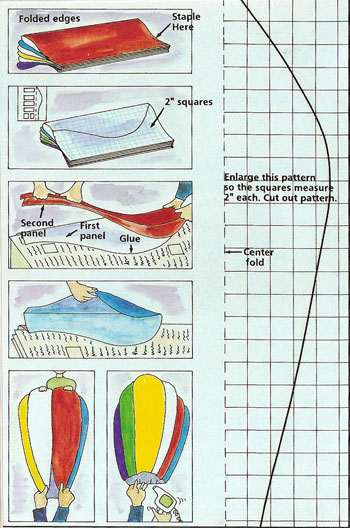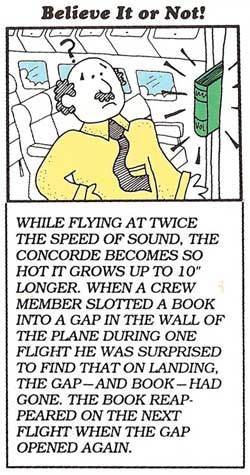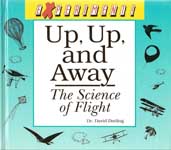UP, UP, AND AWAY: The Science of Flight - 6. Faster and Farther

Figure 1. Computer analysis of Boeing Dreamliner.

Figure 2. An idea for a future space plane.

Figure 3. How the shape of a wing, or airfoil, creates lift.

Figure 4. Glider.

Figure 5. Dandelion seeds.
Scientists are always looking for ways to improve aircraft so that, for example, they can fly faster, carry more passengers, or cargo, or use less fuel.
The fastest passenger plane ever built was Concorde, which could travel at 1,450 miles per hour or more than twice the speed of sound. Some military planes can fly at over 2,000 miles per hour. In the future, however, there will be aircraft capable of even higher speeds.
Moving very quickly through the air causes a plane's wings, body, and engines to become extremely hot. Because of this, new materials are being developed to replace the metal in certain parts of high-performance jet engines and on the leading edges of wings. These materials include so-called ceramics, which are as strong as aluminum but weigh only half as much.
Aircraft designers are also making more use of powerful computers to calculate, for instance, the best shape for aircraft wings and bodies. Previously, the only way to test a new design was to build a scale model and try it out in a wind tunnel. This is both time-consuming and expensive. Today, computers allow many more designs to be tested under a much wider variety of conditions. Even so, wind tunnels are always used to check the computer findings.
Spaceplane 2000
One of the next great breakthroughs in flight may be an aircraft that can fly into space but take off and land using an ordinary runway.
One idea, being developed by the National Aeronautics and Space Administration (NASA), is for a space plane that would have four different types of engines. The first of these would drive the vehicle up to twice the speed of sound. The air coming into the jets would be burned with hydrogen fuel, carried onboard, to provide the forward push.
Another type of jet engine, called a ramjet, would power the plane up to 8 times the speed of sound. Then a third kind of jet, known as a scramjet, would operate up to 20 times the speed of sound. By this time, the plane would be at the edge of the earths atmosphere. The plane would no longer be able to gulp in enough air to burn its fuel. So, the fourth set of engines – rocket engines – would take over. Less than half an hour after takeoff, the space plane would be traveling at 25 times the speed of sound (about 18,000 miles per hour) in an orbit 150 miles high.

A lot of hot air
You will need:
What to do: This is an activity for a large group of people, such as a class or an entire school. It is a competition to see who can design and build an aircraft that can: (1) cover the greatest distance from a fixed starting point, or (2) remains airborne the longest.
The rules of the competition must be decided first, for these set the limits of what entries are and are not allowed. These rules should clearly state if there is any restriction on building materials, method of launch or propulsion, size, and so on. Then the venue and time for the competition must be agreed upon. A gymnasium, for example, would be ideal. Finally, there should be a deadline for competitors to register their entries for the race.
Experiment in depth: This is an activity that might take several hours or several weeks to prepare, depending on how much effort you wish to put into it. It could be the climax, for example, of a class project on flight. It could involve reading books on model aircraft construction, testing various designs in the wind tunnel, and trying "prototype" models in free flight.
The most important point is to decide what type of models are eligible for the competition. Are these to be restricted to just paper gliders or unpowered models of any type, or may they include aircraft driven, for instance, by plastic propellers and rubber bands?
The requirements of the models will be very different depending on whether the competition is judged by the distance flown of the duration of the flight. Perhaps a two-part competition could be organized to allow entries in both categories.
A large indoor site for the competition, such as a sports arena, or gymnasium would be better than one outdoors, since even the slightest breeze could have a big effect on the performance of the models.
To enable a fair assessment, each competitor should be allowed three attempts per model with the best measurement being noted down. A prize for the winner, for example, of an aircraft construction kit might encourage extra effort! |
Around the World in Nine Days
 |
Americans Dick Rutan and Jeana Yeager became the first people to fly non-stop around the world without refueling in their specially constructed Voyager aircraft. They left Edwards Air Force Base in California on December 14, 1986, and returned on December 23. The total length of the flight was 9 days, 3 minutes, and 44 seconds. Voyager had flown for 25,017 miles at an average speed of 116 miles per hour.
The pilot flew the plane from a tiny cockpit measuring just 5½ feet by 21 inches while the other crew member rested in a space measuring 7½ feet by 2 feet.
Voyager was designed by Dick Rutan's brother, Burt, who first sketched his ideas on the back of a paper napkin in a restaurant. The aircraft was built using many novel lightweight materials, including graphite (a form of carbon used in pencil leads) and paper. It had a wingspan of 110 feet and could carry 1,550 gallons of fuel that weighed 4 tons.

